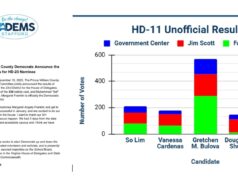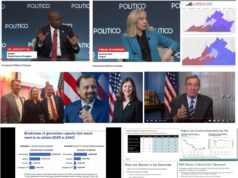
Such errant nonsense is being strenuously peddled in the media. I can only suppose that Karl Rove and Republican strategists are encouraging this foolishness because it is:
1) guaranteed to trick Democrats into losing elections,
2) is a (probably deliberate) misreading of the facts on the ground, and
3) is actually a contrivance of lies and misinformation dressed up in that special, impressive-sounding mumbo-jumbo that con artists employ to flimflam the gullible.
So, if this fairy tale of “centrism” is not the real world, what is? And, what happens if the national Democratic leadership does, or does not buy into the “move-to-the-right” fairy tale?
DEFINING THE CENTER
When it comes to the political spectrum, let us not forget that, as the Republicans have marched steadily rightward, they have changed the geometry of the American body politic. They have actually run over and absorbed old extremist fringe groups on the right, like libertarians, nativists, various white supremecists, un-reconstructed states rightists, and Revelation-based religious zealots. The old middle has been left behind, somewhat surprised to find itself now designated as the left side of the political spectrum, while the old fringe groups on the left (for example neo-Socialists, anarchists, or communists) are regarded as toxic ghosts wandering out there somewhere in the wilderness. Republicans are, in fact, increasingly ideology-based, utterly devoted to the Free Market theory, obedient to the wishes of global corporations and finance, and stridently Christian. This has not stopped them from proclaiming their political mix to be somehow the new mainstream, or center right, and there is less and less overlap between the bases of the two parties.
Calling something “liberal” is taking on the same connotations of toxicity as “socialism” in Republican parlance, which, having successfully muddied definitions, is now using liberal and socialist almost interchangeably as pejoratives. Subjected to a relentless flood of commentary employing such re-definitions, Americans have been re-educated, and generally now accept the Republican claim that defines their party’s “conservativism” as mainstream—- as have many Democrats, who should have known better, but have lost their moorings, among them the self-styled Blue Dogs.
THE ELECTION CONNECTION
How did this old-middle/new-left (which voted for Obama overwhelmingly in 2008) react in 2010, two years into the Obama administration, after two years of economic drudgery and deafened by the continuous klaxon of anti-Obama, anti-“liberal” messaging from the new, “mainstream” Republican right? Exit polls show that “40 percent of voters who felt worse off economically in the last couple of years went Republican by 29 percent after going for Obama in 2008 by 42 percent,” says Mike Lux in OpenLeft; and “the 35 percent of voters who said Wall Street was more to blame than anyone else for the bad economy broke 56-42 for the Republicans.” Lux claims he has never seen such a wide swing in any demographic group before. That 35 percent of voters who blamed Wall Street were what Lux called the “middle class swing voters”(the same middle class populists targeted by Lee Atwater in 1988), and they astonishingly ended up associating Democrats and Obama, not the Republicans, with Wall Street, partly because of how TARP, the “kid glove treatment” of the big banks and AIG by Geithner, the enormous bonuses that followed the bailouts so quickly, and the “failure to prosecute or break up the Too Big to Fail” all came together in one boiling pot in voters’ minds, and partly because of repetitive attacks by obstrunctionist Republicans who never failed to link Obama to it all (“failed stimulus,” “big government take-over of GM,” “socialist Obama care” and so on).
Indeed, Matt Bai in The New York Times said that 41 percent of the voters in 2010 described themselves as conservatives, whereas in 2006 only 32 percent did so. That is a remarkably quick make-over, politically speaking as well as semantically—- if they were the same voters, that is. Mr. Bai contends that this fact disproves claims by what he calls the liberal or Dean wing of the Democratic Party, which is that Democrats lost because Blue Dogs watered down to ineffectiveness any progressive legislation (read, ” Obama betrayed the liberals”). Instead, Bai’s reading of the election is that Yes, it was a referendum, and voters rejected the pet policies of the liberals.
THE VOTERS’ INTENTIONS VS WHAT REPUBLICANS/PUNDITS SAY VOTERS MEANT
Writers at Campaign for America’s Future pointed out an over-looked truth: “Voters don’t think the way journalists and politicians do…. they’re drawn to those parties, ideologies, and people who get things done the way they want them done.” That is, forget labels and personalities, and go for the pragmatist who does what voters want, not what some ideology requires or some pundit reads in the entrails of events.
Poll after poll, including exit polls in the 2010 election, showed repeatedly that voters support policies and programs which, when described factually but without labels, are actually those of liberals, whereas they rejected those of conservatives and “centrists.” Lux quoted from Stan Greenberg’s poll done for the Campaign for America’s Future:
“Swing voters supported a statement about politicians keeping their hands off Social Security and Medicare over a statement about raising the retirement age by 62-36;
Swing voters supported a message about ending tax cuts for those earning over $250,000 a year, adding a bank tax to curb speculative trading, cutting wasteful military spending and ending subsidies to oil companies over a message about cutting 100 billion dollars from domestic programs, raising the Social Security retirement age, and turning Medicare into a voucher program by 51-37;
Swing voters supported a message about challenging China on trade, ending subsidies to corporations that send jobs overseas, and stopping NAFTA-like trade deals over a message about increasing exports, passing more trade agreements, and getting government out of the way by 59-28;
89 percent of swing voters supported a statement about full disclosure of campaign donations and limiting the power of lobbyists;
90 percent of swing voters supported a statement about cracking down on outsourcing and creating jobs by fixing schools, sewers, and roads in disrepair; and
Even when framed in direct opposition to a statement about stopping increased government spending and tax increases, swing voters said they were more worried that we will fail to make the investments we need to create jobs and strengthen the economy by 54-44.”
(Emphasis added)
Another poll found that even 51 percent of Republicans (and a big majority of all voters) supported some form of public option during the health care debates. Another, taken this year, showed that 69 percent of voters (and even 56 percent of Republican voters) support tighter bank regulations. This has to mean that, whether voters says they are “conservative” or not, and whether they voted Republican or not, they are in synch with the ideas of progressives.
AN ELECTORATE IN THIRDS
Chris Bowers on 3 November in DailyKos pointed out that “The Congressional Progressive Caucus replaced the Blue Dogs and the New Democrats as the plurality ideological caucus among the Democrat,” and will make up 39 percent of the House Democratic Caucus because 95 percent of the Progressives were returned to Congress by the voters, but only 46 percent of the Blue Dogs.
You can read this result how you choose; I believe it shows that, when voters are given a choice between a “centrist” Blue Dog peddling a Republican Lite philosophy and the genuine Republican, they go for the real deal Republican, and where a clear Progressive Democrat has been elected by the voters, they approve and keep that real deal Democrat. It may be this also shows a more ideological winnowing out of candidates, but it can also be a warning that, if you run as a Democrat you are expected to be a populist or progressive. Such progressive voters are, I believe, about one-third (give or take) of the electorate. Note: of the electorate, not necessarily of the pool of actual voters.
The old middle, that is, what is now often mis-named left, continues to favor most of the policies and ideals of the 20th century, the “social democratic” mean with its belief that government should improve the lives and protect the general well-being of the average citizenry (not just the favored few), and that therefore technology and science should be encouraged because they made life better, but that simultaneously it is a function of government to protect individual citizens from the depredations of huge corporations and financial institutions. The old middle continues to hold a firm, old-fashioned conviction that individuals’ private lives are not the concern of public officials; dissent is not unpatriotic. This, I believe is the one-third of the electorate that are the so-called swing voters. They are the ones personally damaged the most by the Great Recession. Note: all these old middle ideas are no longer denominated centrist by today’s Republicans and today’s brainwashed commentators; they are “leftist.”
The last third of the electorate is the new radical/reactionary conservatives. The rights of workers (i.e., “Labor”) as compared to business owners (i.e., “Capital”) are being pushed out into the lefty wilderness, as if unworthy of inclusion anywhere within the political spectrum. There is a conflict among these conservatives: a professed hatred of “big government” and love of fiscal conservatism looks hypocritical given that Republicans, when in power, have repeatedly increased the size of the federal government and run budget deficits which ballooned the national debt. In practice, their subservience to big business and Wall Street results in anti-populist policies so that government is used as the handmaiden of business, not as the protector of the average citizen.
NOW WHAT?
Republicans know how to campaign, and they know how to deliver a message and stay on it. (Governing is another matter entirely). The only way they can win an election appears to be to hold and motivate their radical conservative base with extremism, while tapping into or creating among the rest of the population fears for which only Republicans have solutions. Hypocritical, cynical, prevaricating? Often true, but one talent Republicans have developed well is to program Democrats into one trap after another, leading Democrats to fight every election on ground chosen by Republicans, and, basically, to defeat themselves. This is how deluded and angry swing voters were convinced to vote against Democrats, because “Obama had not resolved the economic crisis,” even though that crisis was actually caused by Republican policies and by the big money interests which command the Republicans.
What if Obama falls into the Republican trap being so aggressively promoted by inside-the-Beltway pundits and consultants? What if he accepts “ersatz centrism,” believes the Republican mantra that his too “liberal” policies were rejected by the voters, and follows the chimera of bipartisanship by agreeing to Republican policies like tax cuts for the very wealthy, kowtowing to big business and WallStreet, reducing/privatizing “entitlements,” and shrinking government in the name of panicky deficit-reduction? This would be a disaster for Obama, for the Democrats, and for the American people. These are not only the very policies that two thirds of the electorate has said they despise, they are the very same Bush policies that enabled the economic meltdown. They do not work. Obama never got credit for the bipartisanhip he has already tried; he lay down with Blue Dogs to placate them and to meet conservative demands…. when his efforts did occasionally turn into legislation, it was infested with fleas. This is what pragmatic centrism looks like.
From here on, Republicans have said flat out it is all about making Obama fail, so they can win the whole shebang in 2012; the heck, in other words, with solving problems of that middle third, the heck with governing, except to reward their big money backers. Now, as never before, Obama must show political leadership, demand that Republicans participate in doing what the voters really want, not what free marketeering big business flunkies tell them they want.
This means real, direct job creation, serious regulation of greedy corporations and financial institutions, solutions that work immediately to resolve the foreclosure crisis (like forcing cram-downs on the mortgages), extending unemployment compensation, re-building infrastructure, cleaning up the health care bill as needed and speeding its implementation (perhaps extending Medicare down to the age of 55?), true campaign finance reform and disclosure, prosecution and punishment for fraud and malfeasance by corporations instead of only little home owners, maybe even confronting mission creep by the Pentagon and reducing our foreign commitments by re-defining the so-called war on terror, and so on. No more ditzing around. Do all this, show a spine, call the Republicans’ bluff up front by proposing these solutions in the State of the Union address would be ideal), and tell the American people all about it every step of the way, lead them, educate them—- they are waiting to be told what they must do to help themselves—- let Americans know we are all in this together, such a different message from that of the Republicans!
Draw a line in the sand so the electorate finally, clearly, understands that Democrats are the Party of the People. It can be couched in bipartisan tones, in patriotic tones, as a call to work together pragmatically. Do not do this, and you have enabled many future Republican victories, and probably destroyed the Democratic Party.















